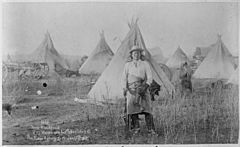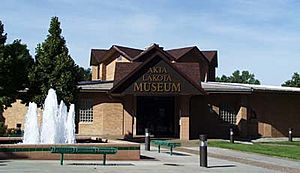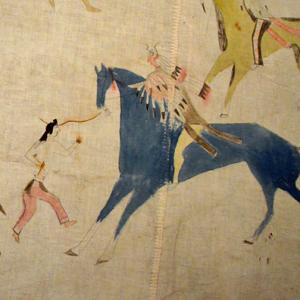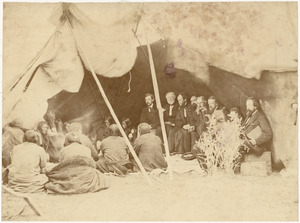Lakota people facts for kids

|
|
| Total population | |
|---|---|
| 115,000+ enrolled members (2015 census) | |
| Regions with significant populations | |
| United States (North Dakota and South Dakota) |
|
| Languages | |
| English, Lakota | |
| Religion | |
| traditional tribal religion | |
| Related ethnic groups | |
| other Sioux peoples (Santee, Sisseton Wahpeton Oyate, Yankton, Yanktonai) |
The Lakota (say "Lah-KOH-tah") are a group of Native American people. They are also known as the Teton Sioux. The Lakota are one of the main groups within the larger Sioux people. Today, many Lakota live in North Dakota and South Dakota. They speak their own language, called Lakȟótiyapi, which is part of the Siouan language family.
The Lakota people are made up of seven main groups, sometimes called "sub-tribes":
- Sičháŋǧu (Brulé, meaning "Burned Thighs")
- Oglála ("They Scatter Their Own")
- Itázipčho (Sans Arc, meaning "Without Bows")
- Húŋkpapȟa (Hunkpapa, meaning "End Village")
- Mnikȟówožu (Miniconjou, meaning "Plant Near Water")
- Sihásapa ("Blackfeet" or "Blackfoot")
- Oóhenuŋpa (Two Kettles)
Many important Lakota people have shaped history. These include Tȟatȟáŋka Íyotake (Sitting Bull) from the Húnkpapȟa, and Maȟpíya Lúta (Red Cloud) from the Oglála. Others are Tȟašúŋke Witkó (Crazy Horse) from the Oglála and Miniconjou, and Siŋté Glešká (Spotted Tail) from the Brulé. More recently, Billy Mills (Oglála) became an Olympic gold medalist. Activists like Russell Means (Oglála) also worked for Lakota rights.
Contents
History of the Lakota People
People who spoke Siouan languages may have first lived near the lower Mississippi River. They might have moved to the Ohio Valley later. These groups were farmers and may have been part of the Mound Builder civilization long ago.
Lakota stories say they once lived near the Great Lakes. Here, they hunted, fished, and gathered wild rice. They also grew some corn. Later, in the 1600s, they lived in the upper Mississippi area. This is now parts of Minnesota, Wisconsin, Iowa, and the Dakotas.
Conflicts with the Anishinaabe and Cree peoples pushed the Lakota west. They moved onto the Great Plains in the mid-to-late 1600s.
Early Lakota history is kept in their winter counts. These are like picture calendars painted on animal hides. The 'Battiste Good winter count' tells Lakota history back to 900 CE. It says that White Buffalo Calf Woman gave the Lakota people the White Buffalo Calf Pipe.
Around 1730, the Cheyenne people showed the Lakota how to use horses. The Lakota called horses šuŋkawakaŋ, meaning "dog of power." After getting horses, Lakota life changed. It became centered on hunting buffalo from horseback.
In 1660, French explorers thought there were about 28,000 Sioux people. This included the Lakota, Santee, Yankton, and Yanktonai. By 1805, the Lakota population was about 8,500. It grew to 16,110 by 1881. This was rare, as many Native American tribes saw their populations shrink. By 2010, the number of Lakota people grew to over 170,000. About 2,000 of them still speak the Lakota language.
After 1720, the Lakota split into two main groups. The Saône moved to the Lake Traverse area. The Oglála-Sičháŋǧu lived in the James River valley. By 1750, the Saône had moved east of the Missouri River. The Oglála and Brulé followed them ten years later.
Large and strong villages of the Arikara, Mandan, and Hidatsa tribes had stopped the Lakota from crossing the Missouri River. But a terrible smallpox epidemic from 1772 to 1780 killed many people in these tribes. This allowed the Lakota to cross the river into the High Plains. These new arrivals were the Saône, who were good riders and very confident. They quickly spread out.
In 1765, a Saône group led by Chief Standing Bear found the Black Hills (the Paha Sapa). This land belonged to the Cheyenne at the time. Ten years later, the Oglála and Brulé also crossed the Missouri. The Lakota pushed the Cheyenne west to the Powder River country. The Lakota then made the Black Hills their home.
The first time the United States met the Lakota was during the Lewis and Clark Expedition in 1804–1806. This meeting was tense. Lakota groups would not let the explorers go upstream. The expedition got ready for a fight, but it did not happen.
Some Lakota groups helped the United States Army in a war against other tribes. This was during the Arikara War in 1823.
In 1843, southern Lakota attacked a Pawnee village in Nebraska. They killed many people and burned homes. The Lakota also caused great harm to the Pawnee in 1873. This was during the Massacre Canyon battle.
Later, the United States built Fort Laramie on Lakota land without permission. In 1851, they signed the Fort Laramie Treaty. This treaty was meant to protect European-American travelers on the Oregon Trail. Before this, the Cheyenne and Lakota had attacked settlers. This was because of competition for resources and settlers moving onto their lands.
The 1851 treaty said the Lakota had control over the Great Plains. In return, European Americans could travel freely on the Oregon Trail. The treaty said this would last "as long as the river flows and the eagle flies."
The U.S. government did not stop people from settling on Lakota land. So, the Lakota and other groups attacked settlers and wagon trains. This was their way of fighting back. On September 3, 1855, 700 U.S. soldiers attacked a Lakota village in Nebraska. They killed about 100 men, women, and children. This was revenge for the Grattan massacre.
More short "wars" followed. From 1862 to 1864, Native American people from the "Dakota War of 1862" in Minnesota fled west. They joined their allies in Montana and Dakota Territory. After the American Civil War, more illegal settlements led to new wars on the Plains.
The Lakota considered the Black Hills sacred. They did not want people to mine there. Between 1866 and 1868, the U.S. Army fought the Lakota and their allies. This was over U.S. forts built to protect miners on the Bozeman Trail. Oglala Chief Red Cloud led his people to victory in Red Cloud's War.
In 1868, the United States signed the Fort Laramie Treaty of 1868. This treaty said the Black Hills would be free from white settlement forever. But four years later, gold was found there. Many prospectors then rushed into the area.
Attacks on settlers and miners were met by the army. Commanders like Lieutenant Colonel George Armstrong Custer led these forces. General Philip Sheridan even told his troops to hunt and kill buffalo. This was a way to "destroy the Indians' commissary," meaning their food supply.
The Lakota, Arapaho, and Northern Cheyenne fought many battles after 1860. They successfully slowed down General George Crook's army at the Battle of the Rosebud. This stopped Crook from finding their camp. A week later, they defeated the U.S. 7th Cavalry in 1876. This was at the Battle of the Greasy Grass.
Custer attacked a camp of several tribes, but it was much larger than he thought. The combined forces, led by Chief Crazy Horse, killed 258 soldiers. They wiped out Custer's entire group. More than half of the soldiers in the regiment were killed or hurt.
The Lakota and their allies did not enjoy their victory for long. The U.S. Congress gave money to make the army bigger. The stronger U.S. Army defeated the Lakota groups in many battles. This ended the Great Sioux War of 1876 in 1877. The Lakota were eventually forced to live on reservations. They could not hunt buffalo outside these areas. They had to accept food from the government.

In 1877, some Lakota groups signed a treaty. This gave the Black Hills to the United States. But this treaty was very controversial. Many Lakota leaders did not agree with it. Small fights continued in the Black Hills.
Fourteen years later, Sitting Bull was killed. This happened at the Standing Rock Indian Reservation on December 15, 1890. The U.S. Army attacked Spotted Elk's (also known as Bigfoot) Mnicoujou Lakota group. This was on December 29, 1890, at Pine Ridge. They killed 153 Lakota people, including many women and children. This event is known as the Wounded Knee Massacre.
Today, most Lakota live on five reservations in western South Dakota:
- Pine Ridge Indian Reservation: Home to the Oglála, the largest Lakota group.
- Rosebud Indian Reservation: Home to the Upper Sičhánǧu or Brulé.
- Lower Brule Indian Reservation: Home to the Lower Sičhaŋǧu.
- Cheyenne River Indian Reservation: Home to several other Lakota groups. These include the Mnikȟówožu, Itázipčho, Sihásapa, and Oóhenumpa.
- Standing Rock Indian Reservation: Home to the Húŋkpapȟa and people from other groups.
Lakota also live on the Fort Peck Indian Reservation in Montana. Some are on the Fort Berthold Indian Reservation in North Dakota. There are also small reserves in Saskatchewan and Manitoba, Canada. Their ancestors fled there during the Minnesota and Black Hills wars.
Many Lakota also live in cities like Rapid City, South Dakota and Denver. Lakota elders joined the Unrepresented Nations and Peoples Organization (UNPO). They did this to protect their culture and land rights.
Lakota Government
Government in the United States
The Lakota Sioux are seen as a "nation" within the United States. They have their own governments. These are led by elected officials on their reservations. These tribes work directly with the U.S. federal government. This is mainly through the Bureau of Indian Affairs.
People living on reservations can also vote in U.S. elections. They are represented by elected officials at the state and national levels.
Members of a tribe can vote in elections for their reservation. Each reservation has its own rules for who can be a member. They also have their own government style. Most use a tribal council model. A chairman or president is elected by all the voters.
- The current President of the Oglala Sioux is Kevin Killer. They are mainly on the Pine Ridge reservation.
- The President of the Sičháŋǧu Lakota at Rosebud is Rodney M. Bordeaux.
- The Chairwoman of the Standing Rock reservation is Janet Alkire. This reservation includes several Lakota groups.
- The Chairman of the Cheyenne River Sioux Tribe is Harold Frazier. This tribe includes the Mnikȟówožu, Itázipčho, Sihá Sápa, and Oóhenuŋpa groups.
- The Chairman of the Lower Brule Sioux Tribe is Boyd I. Gourneau.
Tribal governments are semi-autonomous. This means they have some independence from state laws. For example, they can run Indian gaming on their land. However, they are still overseen by the United States Congress. The Bureau of Indian Affairs also helps manage their affairs.
Government in Canada
Nine groups of Dakota and Lakota live in Manitoba and southern Saskatchewan, Canada. They have about 6,000 registered members. They are called First Nations. They get rights and help from the Canadian government. But they are not considered "treaty Indians." This means they did not get land or money from old treaties. In 2008, the Dakota turned down a $60-million land-rights offer.
Independence Movement
Some Lakota groups have worked for independence. They have filed claims against the U.S. government. They say the Black Hills were taken illegally in the 1800s.
In 1980, the Supreme Court agreed with them. In United States v. Sioux Nation of Indians, the court said eight Sioux groups should get $122 million. This was for their Black Hills land claim. But the Sioux have refused the money. They believe taking the money would mean giving up their claim to the Black Hills. The money is still in a government account. With interest, it grew to over $1 billion by 2011.
In September 2007, the United Nations passed a declaration. It was about the rights of Indigenous Peoples. Canada, the United States, Australia, and New Zealand did not sign it at first.
On December 20, 2007, a small group led by activist Russell Means went to Washington D.C. They said the Lakota Sioux were leaving all treaties with the U.S. government. But these activists did not represent any elected tribal government.
Official Lakota tribal leaders said they did not support this group. Rodney Bordeaux, a Lakota chairman, said, "They don't speak for us."
Means announced "The Republic of Lakotah." He said it was a separate nation. It would control land in South Dakota, North Dakota, Nebraska, Wyoming, and Montana. The group said they did not represent the tribal governments. These governments were "set up by the BIA."
"The Lakota Freedom Delegation" did not include any elected tribal leaders. Means had run for president of the Oglala Sioux tribe before and lost. Several elected tribal governments said they were not part of this declaration. No elected tribal governments supported it.
Current Activism
The Lakota people gained national attention for issues with foster care. A story called "Lost Children, Shattered Families" was on NPR. It talked about Lakota children being taken from their homes. This was done by South Dakota's Department of Social Services (D.S.S.).
Lakota activists like Madonna Thunder Hawk and Chase Iron Eyes say that Lakota grandmothers are unfairly denied the right to foster their own grandchildren. They are working to change how money is used. They want federal money to go to new tribal foster care programs. This would be a big change from the state's control over Lakota foster children.
A short film, Lakota in America, was made by Square. It shows Genevieve Iron Lightning, a young Lakota dancer. She lives on the Cheyenne River Indian Reservation, which is one of the poorest communities in the United States.
Ethnonyms (Names)
The name Lakota comes from their own word, Lakota. It means "feeling affection, friendly, united, allied." Early French records did not separate the Teton group. They called them "Sioux of the West" or grouped them with other Sioux.
The names Teton and Tetuwan come from the Lakota word thítȟuŋwaŋ. The meaning of this word is not clear. Other Sioux groups used this term for the Lakota. There are many ways this name was spelled over time.
Early French writings called the Lakota "Sioux" with other words. For example, "Sioux of the West" or "Sioux of the Plains."
Today, many tribes still officially call themselves Sioux. In the 1800s and 1900s, the U.S. government used this name for all Dakota/Lakota people. However, some tribes now use their traditional names. For example, the Rosebud Sioux Tribe is also called the Sičháŋǧu Oyáte (Brulé Nation). The Oglala often use Oglála Lakȟóta Oyáte. The Lakota are the westernmost of the three Sioux groups. They live in both North and South Dakota.
Lakota Reservations

Today, about half of all enrolled Sioux live off reservations.
Lakota reservations recognized by the U.S. government include:
- Oglala (Pine Ridge Indian Reservation, South Dakota and Nebraska)
- Sicangu (Rosebud Indian Reservation, South Dakota) & (Lower Brule Indian Reservation, South Dakota)
- Hunkpapa (Standing Rock Reservation, North Dakota and South Dakota)
- Miniconjou (Cheyenne River Sioux Reservation, South Dakota)
- Itazipco (Cheyenne River Sioux Reservation, South Dakota)
- Siha Sapa (Cheyenne River Sioux Reservation, South Dakota)
- Ooinunpa (Cheyenne River Sioux Reservation, South Dakota)
Some Lakota also live on other Sioux reservations:
- Santee Indian Reservation, in Nebraska
- Crow Creek Indian Reservation in Central South Dakota
- Yankton Indian Reservation in Central South Dakota
- Flandreau Indian Reservation in Eastern South Dakota
- Lake Traverse Indian Reservation in Northeastern South Dakota and Southeastern North Dakota
- Lower Sioux Indian Reservation in Minnesota
- Upper Sioux Indian Reservation in Minnesota
- Shakopee-Mdewakanton Indian Reservation in Minnesota
- Prairie Island Indian Reservation in Minnesota
In Canada, some Lakota live on the Wood Mountain First Nation reserve. This is near Wood Mountain Regional Park in Saskatchewan.
See also
 In Spanish: Lakota para niños
In Spanish: Lakota para niños
- Lakota mythology
- List of Lakota people
- Native American tribes in Nebraska







